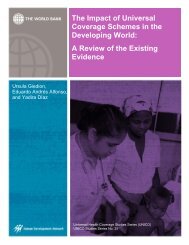11ZAQGM
11ZAQGM
11ZAQGM
You also want an ePaper? Increase the reach of your titles
YUMPU automatically turns print PDFs into web optimized ePapers that Google loves.
Key Activities and Innovations<br />
The community of Abrha Weatsbha carries out a number of<br />
overlapping and complementary activities in the areas of communitybased<br />
adaptation, food security, eco-agriculture, sustainable forest<br />
management, sustainable land management, and water resource<br />
management.<br />
Improved water management<br />
Northern Ethiopia typically experiences unreliable rainfall. These<br />
patterns have only intensified with climate change, resulting in<br />
prolonged droughts, late rains, shorter rainy seasons, and extended<br />
dry spells during the growing season. This poses acute challenges<br />
for a population that is dependent on agriculture for subsistence,<br />
food security and livelihoods. Abrha Weatsbha has responded with<br />
interventions to improve the water-holding capacity of the soil by<br />
recharging groundwater and digging shallow wells to provide for<br />
supplementary irrigation.<br />
Changing local agricultural practices<br />
Abrha Weatsbha Natural Resource Management Initiative also<br />
engages local farmers to improve environmental sustainability, crop<br />
yields and agricultural productivity. This has been an exercise in<br />
behaviour change, as some traditional agricultural practices – many<br />
in use due to the need for quick, low-cost returns – have produced<br />
negative impacts on the local environment. The group promotes<br />
Improvements to the integrity and content of soil have led to<br />
subsequent improvements in water-holding capacity. Tree planting,<br />
ecosystem restoration activities, and the use of manure for compost<br />
and organic fertilizers have not only improved the integrity of the soil<br />
and land, but improved water security by facilitating groundwater<br />
recharge, or what community members refer to as “the water bank in<br />
the soil”. This reserve of water has increased community resilience to<br />
droughts. Improvements in soil quality have translated to increased<br />
absorption of water into the soil, which has also reduced incidence<br />
of flooding.<br />
The community also constructs small dams, creates water catchment<br />
ponds, and builds trenches and bunds to restore groundwater<br />
functioning. This has resulted in greater flexibility with irrigation,<br />
making year-round agricultural production possible and allowing<br />
local farmers to grow fruits and vegetables that were previously<br />
untenable during the dry season.<br />
14






